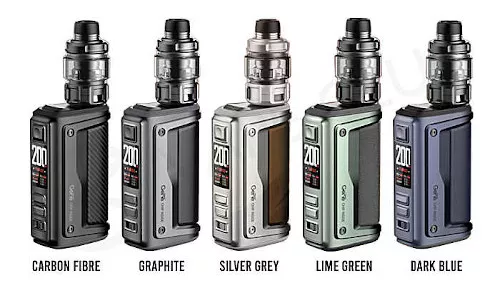In this review, I will talk about a stylish, powerful, but extremely simple box mod for two 18650 batteries from Voopoo called ARGUS GT II.
Macro
Engineers from Voopoo continue to delight vapers by producing not only low-power pods, but also quite solid box mods with a power of up to 200 Watts. Most recently, DRAG 4 was released, and now a representative of the ARGUS line with the GT II index has hit store shelves. online vape shop australia Even though both of these devices are based on the same chip, their differences are significant. And both in design and functionality.
Packaging Review of Voopoo ARGUS GT II Mod – packaging
The ARGUS GT II mod can be purchased in one of three configurations: exclusively as a single battery pack (as in this review), complete with a Uforce-L tank, or complete with a Maat tank. In any case, the kit will be packed in a stylish tin box, and covered with a cover stylized as packaging cardboard. On the front side you will see a drawing of the mod, a description of its main features and notes about the prizes received. The reverse side of the packaging contains a description of the package, warnings, the manufacturer’s address, certificate icons and stickers with an authentication code, the color of the device and its serial number.
The sides of the cardboard packaging contain QR codes with encrypted links to social networks, as well as a tear strip. Which, in fact, is not needed here, because the outer shell can simply be moved to the side. The main box, as I wrote above, is made of thin metal and decorated with embossing on the lid.
Contents of delivery
Inside you will find instructions in several languages, a reminder about batteries, a small cable for charging USB Type-A to USB Type-C (it lies alone in a box labeled Accessory) and the ARGUS GT II itself in plastic lodgement.
ARGUS GT II design
Although the mod is part of the Voopoo Argus family, its appearance is more reminiscent of a line of vapes from a completely different manufacturer, namely GeekVape Aegis. The metal bracket and soft insert appeared there in the clearest possible view. But let’s not scold the designers too much; over the eight years of the company’s history, all possible design options have been used and it’s already quite difficult to make something completely different from one of the competitors. In defense of Voopoo, I will note that here the design is more strict, with less futurism and an almost complete absence of oblique lines. Although a certain roundness and smoothness, unlike the same extremely brutal Drag 4, is present.
In any color you will get a surprisingly harmonious and seamless device. At first it will seem that the insert made of soft material “under the skin” with an unnatural texture from wood to carbon fiber is somewhat inappropriate. But then you get used to it and you stop paying attention to this dissonance. But the comfortable grip and tactile sensations continue to please. There are simply no eye-catching decorations or elaborate elements here. Even the decorative screws on the sides are made with taste and sometimes it really seems like they are holding something. A barely noticeable engraving on the side reminds you of the model of the built-in chip, and the inscription on the “soft” part reminds you of the name of the device itself. But the most interesting thing can be seen upon closer acquaintance.
Battery cover
At the base, the first thing you notice is that the body is not entirely metal. The lid is separated from the base by a gray latex insert, which performs not so much a decorative as a practical function – it protects the insides from moisture penetration (implements the same IP68 protection). The lid itself is absolutely flat, but thanks to the same silicone border it does not touch the table and will not scratch much during long-term use.
The hatch is fixed with a sliding “button”, which very tightly and reluctantly changes its location. But this is even good, since the battery compartment will definitely never open accidentally. Inside you can see cameras for two 18650 batteries and a balancing contact “pin”. Two more spring-loaded contacts are hidden deep in the case, and on the flat brass plate of the cover there are “+” and “-” signs visible, indicating the correct way to install the batteries.
Battery installation
A striking example of “how not to do it.” The batteries in the photo above are not installed correctly! I noticed this after I took all the photos.
I would like to draw your attention to the fact that only batteries in the “native” heat shrink can be easily and confidently installed in the mod. If you repacked the cans yourself and allowed wrinkles, or your heat shrink is extra strong and thick, the battery may not physically fit into the place intended for it.
Connector
The top part of the mod is completely flat and is also separated from the body by a silicone spacer. The 510 connector has a spring-loaded positive pin and a steel base, which will ensure its long operation and prevent damage to the threaded part. But I can’t say the same about the surface of the lid itself. Over time, scratches will appear on it in the form of open rings from small and hard particles that accidentally fall on the base of the evaporators.
Charging port
A strange thing on the side of the connector hides a USB Type-C charging port. To access it, the protruding part must be moved towards the connector. Inside, the port is surrounded by silicone and, most likely, is also protected from moisture when closed.
Charging process
The manufacturer promised a charging current of 3 Amps. While checking this statement, I experienced an inexplicable embarrassment. The mod categorically refused to charge Samsung 30A batteries with a current of more than 0.15 A, but at the same time charged the Murata VTC5A with a current of 2.3 Amperes. I don’t know what he needs to supply to achieve the promised 3 Amps.
Now let us get back to the installation of evaporators on the mod: the optimal mounting diameter of the latter is 24 millimeters. Anything thicker will not hang very nicely on the sides and may not allow the charging module cover to open fully.
Screen and controls
The mod’s controls are represented by three unlabeled buttons and one switch. It is logical to assume that the button above the screen is Fire, immediately below it is “+”, and just below it is “-”. The screen is color, but not the brightest, displays the optimal amount of necessary information: power or temperature in large numbers, operating mode in text, charge of each battery (both in the form of a strip and in percentage numbers), evaporator resistance, voltage, current puff time and total number of puffs taken.
The switch at the very bottom simply blocks all buttons on the device. Which can be convenient, but it can also be annoying, because clicking it only once is almost impossible; holding the device in your hands, you involuntarily “drive” it back and forth.
The device turns on after pressing the Fire button five times, shows the Voopoo logo, and then its name, chip name and firmware version. By default, ARGUS GT II is in SMART mode, which automatically selects power based on the resistance of the installed evaporator. At the same time, it can be changed manually from 5 to 80 Watts using the “+” and “-” buttons in steps of 1 Watt; the chip simply will not allow you to increase the power more, issuing a corresponding warning.
Pressing “+” and “-” at the same time will open a menu with exactly four items:
MODE – selection of vaping mode
SETTING – device settings
PUFF=0 – puff counter reset
BRIGHTNESS – brightness setting
DISPLAY TIME – time before the screen automatically turns off, from 10 to 120 seconds
BACK – return to menu
ABOUT DIVECE – information about ChipID and Level Code. What this is, I don’t have the slightest idea, and there are no instructions written about this item at all.
The device has exactly four operating modes:
SMART – automatic power selection depending on the resistance of the evaporator and limitation in manual settings to 80 Watts. The interface turns orange.
RBA – completely manual power setting from 5 to 200 Watts. Interface – blue.
TURBO – the same RBA mode with manual power selection from 5 to 200 Watts, but a little sharper at the beginning (automatic pre-hit). The interface is red.
TC – thermal control mode. The power selection is replaced by choosing the desired temperature from 100 to 315 degrees Celsius, and then from 200 to 600 degrees Fahrenheit. You can adjust the power by pressing the Fire button three times. But in any case there will be a limitation of a maximum of 80 watts. Thermal control mode provides three customized profiles: Ti – titanium, NI – nickel, SS – stainless steel. There is no manual selection of temperature coefficient. But there are three slots for saving your settings. Just press Fire and “+” at the same time to record them in the next slot, and then select them if necessary. The interface is green.
Naturally, I couldn’t ignore checking the maximum power output of the device. Based on the evaporator resistance of 0.06 Ohm, the following came out:
200 Watts – 3.21 Volts. Actual power (3.21*3.21)*0.06=177 Watts
180 Watts – 3.21 Volts. Actual power (3.21*3.21)*0.06=177 Watts
160 Watts – 3.2 Volts. Actual power (3.2*3.2)*0.06=170 Watt
140 Watts – 3.06 Volts. Actual power (3.06*3.06)*0.06=156 Watts
120 Watts – 2.83 Volts. Actual power (2.83*2.83)*0.06=133 Watts
It is logical that the readings on the screen are very approximate and 200 Watts are marketing. But for almost everyone, a miracle didn’t happen. It’s definitely not a matter of batteries; for the test I used the proven Murata VTC5A, which are capable of delivering much more current.
Total
ARGUS GT II turned out to be a very, very nice device. Thoughtful and high-quality, devoid of most inappropriate, at least in my opinion, settings. If you have a tank with replaceable evaporators, feel free to set the SMART mode, if the tank being serviced is RBA, and if it’s a drip tank, then choosing TURBO will be the best solution. Even those who like to play around a little with thermal control will not be offended. And everything else, in fact, is not needed at all.
It may not have 200 watts, but the actual 177 is enough for any winding. Moreover, the most extreme ones from 0.05 Ohm are supported. Fast charging is basically a capricious thing, and you can only get the full 3 Amps with ideal batteries. But even if this is what you have, I would still recommend purchasing an external charger.
I treat water resistance without unnecessary pathos. It’s good, I’ll worry less in light rain and I’ll be sure that dust won’t get into the filling. Well, for the mechanical blocking it’s a plus for the engineers’ karma.

